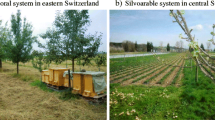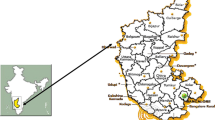Abstract
Agroforestry systems are widely recognized as an important way to address numerous environmental challenges in tropical areas. They represent a sustainable alternative form of land-use for small-scale agriculture, responding to the economic development needs of communities and offering a number of ecosystem services. This article presents an evaluation of the short- and medium-term profitability of two experimental agroforestry systems where fruit trees are predominant, which were established in 2009 in the Tapajós region of the Brazilian Amazon, state of Pará. An analysis of net present value (NPV) confirms that the two experimental systems studied recover their total implementation and operating costs within a 20 years time horizon. These results underlie that prices of inputs are stable and farmers have access to markets, credit, and agricultural knowledge. The two experimental systems are compared to plots under traditional slash-and-burn cultivation, and Bragantino system. The results support changes to public policies in order to facilitate alternatives to slash-and-burn cultivation by supporting access to credit, knowledge of alternative agricultural practices, transportation systems, and industries that transform agricultural products. The consideration of ecosystem services should add a supplementary argument in favour of policies that promote agroforestry systems and thus limit the practice of slash-and-burn subsistence agriculture.

Similar content being viewed by others
References
Bahamondes M (2003) Poverty-environment patterns in a growing economy : farming communities in arid central Chile. World Dev 31(11):1947–1957
Bellow JG, Hudson RF, Nair PKR (2008) Adoption potential of fruit-tree-based agroforestry on small farms in the subtropical highlands. Agrofor Syst 73(1):23–36
Blinn CE, Browder JO, Pedlowski MA, Wynne RH (2013) Rebuilding the Brazilian rainforest: agroforestry strategies for secondary forest succession. Appl Geogr 43:171–181
Browder JO, Wynne RH, Pedlowski MA (2005) Agroforestry diffusion and secondary forest regeneration in the Brazilian Amazon: further findings from the Rondônia Agroforestry Pilot Project (1992–2002). Agrofor Syst 65(2):99–111
Campello EFC, Silva GTA, Nobrega PO, Vieira ALM, Franco AA, Resende AS (2007) Sistemas agroflorestais na Mata Atlântica: a experiência da Embrapa Agrobiologia. Circular Técnica, Embrapa
CEASA-PA (2009) Cotação de preços––Centrais de Abastecimento do Estado do Pará. http://www.ceasa.pa.gov.br/. Accessed 21 Septembre 2009 2009
Cravo MS, Corteletti J, Nogueira OL, Smyth TJ, De Souza BDL (2005) Sistema Bragantino: Agricultura Sustentavel para a Amazonia. Documentos, Embrapa
Current D, Scherr SJ (1995) Farmer costs and benefits from agroforestry and farm forestry projects in Central America and the Caribbean : implication for policy. Agrofor Syst 30:87–103
de Sá CP, dos Santos JC, Lunz AMP, Franke IL (2000) Análise financeira e institutionsl dos três principais sistemas agroflorestais adotados pelos produtores do reca. Circular Técnica, vol 33. Embrapa, Porto Velho
Droulers M (2004) L’Amazonie : vers une développement durable. Armand Colin, Paris
Dubé F, Couto L, Silva ML, Leite HG, Garcia R, Araujo GAA (2002) A simulation model for evaluating technical and economic aspects of an industrial eucalyptus-based agroforestry system in Minas Gerais, Brazil. Agrofor Syst 55:73–80
Farella N (2005) Les fermes de la région frontière du Tapajós en Amazonie brésilienne : relations entre les origines familiales, les pratiques agricoles, les impacts sur les sols et le déboisement. Université du Québec à Montréal, Montréal
Farella N, Lucotte M, Davidson R, Daigle S (2006) Mercury release from deforested soils triggered by base cation enrichment. Sci Total Environ 368:19–29
Fearnside PM (2005) Deforestation in Brazilian Amazonia : history, rates ans Consequences. Conserv Biol 19:680–688
Fioravanti C (2008) Terra protegida. na Amazônia, técnica de cultivo reaproveita a capoeira em vez de quima-la. Persquisa FAPESP 150:87–89
Franzel S (1999) Socioeconomic factors affecting the adoption potential of improved tree fallows in Africa. Agrofor Syst 47:305–321
Franzel S, Scherr SJ (2002) Introduction. p. 1–11. In: Franzel S, Scherr SJ (eds) Trees on the farm: assessing the adoption potential of agroforestry practices in Africa. CABI, Wallingford, pp 1–11
Grado SC, Hovermale CH, St-Louis DG (2001) A financial analysis of a silvopasture system in southern Mississippi. Agrofor Syst 53:313–322
Guentert A (2010) Analyse des représentations sociales des agriculteurs et des agriculteurs-pêcheurs familiaux, hommes et femmes, de la région de la rivière Tapajós (Pará, Brésil) concernant la technique de la coupe et du brûlis et les pratiques agricoles alternatives. M.Sc. Thesis presented at Université du Québec à Montréal, Montréal, Qc, Canada
Guimarães AL, Uhl C (1997) Rural transport in Eastern Amazonia : limitations, options, and opportunities. J Rural Stud 13(4):429–440
Hedden-Dunkhorst B, Denich M, Vielhauer K, Mendoza-Escalante A, Börner J, Hurtienne T, De Sousa Filho FR, De Abreu Sá TD, Costa FA (2003) Forest-based fallow systems : a safety net for smallholders in the Eastern Amazon ? Paper presented at the international conference on rural livelihoods, Forests and Biodiversity, Bonn, Germany, 19-23 Mai 2003
Hoch L, Pokorny B, Jong W (2012) Financial attractiveness of smallholder tree plantations in the Amazon: bridging external expectations and local realities. Agrofor Syst 84(3):361–375
IBGE (2010) Dados distritais. Censo demografico, Brasilia
Margulis S (2004) Causes of deforstation of the Brazilian Amazon. World Bank Working Paper no.22. World Bank, Washington, DC
Marra M, Pannell DJ, Abadi Ghadim A (2003) The economics of risk, uncertainty and learning in the adoption of new agricultural technologies: where are we on the learning curve? Agric Syst 75(2–3):215–234
McGinty MM, Swisher ME, Alavalapati J (2006) Agroforestry adoption and maintenance: self-efficacy, attitudes and socio-economic factors. Agrofor Syst 73(2):99–108
McNeely J, Schroth G (2006) Agroforestry and Biodiversity Conservation––traditional practices, present dynamics, and lessons for the future. Biodivers Conserv 15(2):549–554
Mercer DE (2004) Adoption of agroforestry innovations in the tropics: a review. Agrofor Syst 61–62(1–3):311–328
Miller RP, Nair PKR (2006) Indigenous agroforestry systems in Amazonia: from prehistory to today. Agrofor Syst 66:151–164
Murphy L, Bilsborrow R, Pichon F (1997) Poverty and prosperity among migrant settlers in the Amazon rainforest frontier of Ecuador. J Dev Stud 34(2):35–65
Nair PKR (1993) An introduction to agroforestry. Kluwer Academic, Dordrecht
Nair PKR (2012) Climate Change Mitigation: a low-hanging fruit of Agroforestry. In: Nair PKR, Garrity D (eds) Agroforestry––The future of global land use, vol 9., Advances in AgroforestrySpringer, Netherlands, pp 31–67
Nepstad DC, Soares-Filho BS, Merry FD, Lima A, Moutinho P, Carter J, Bowman MS, Cattaneo A, Rodrigues H, Schwartzman S, McGrath DG, Stickler CM, Lubowski R, Piris-Cabezas P, Rivero S, Alencar A, Almeida O, Stella O (2009) The end of deforestation in the Brazilian Amazon. Science 326:1350–1351
Oliveira AD, Macedo RLG (1996) Sistemas agroflorestais: considerações técnicas e econômicas. Lavras, Brazil
Pimentel D, Wightman A (1999) Economic and environmental benefits of agroforestry in food and fuelwood production. In: Publishers FL (ed) Agroforestry in sustainable agricultural systems. Boca Raton, pp 295–317
Puri S, Nair PKR (2004) Agroforestry research for development in India; 25 years of experiences of a national program. Agrofor Syst 61–62(1–3):437–452
Puttanayak S, Mercer DE, Sills E, Yang J (2003) Taking stock of agroforestry adoption studies. Agrofor Syst 57:173–186
Ramalho M (2006) Science and development network. http://www.scidev.netiNewslindex.cfm?fuseaction=readNews&itemid=3081&Janguage. Accessed 21 september 2009 2009
Reinhardt TE, Ottmar RD, Castilla C (2001) Smoke impacts from agricultural burning in a rural Brazilian town. J Air Waste Manag Assoc 51:443–450
Ribeiro H, Assunção JV (2002) Efeitos das queimadas na saúde humana. Estudos avançados 16. http://www.scielo.br/scielo.php?pid=S0103-40142002000100008&script=sci_arttext. Accessed 21 September 2009
Ribeiro RNS, de Santana AC, Tourinho MM (2004) Análise Exploratória da Socioeconomia de Sistemas Agroflorestais em Várzea Flúvio-Marinha, Cametá-Pará, Brasil. Rev Econ Sociol Rural 42(1):133–152
Romaña CA, Pizarro JC, Rodas E, Guilbert E (1999) Palm trees as ecological indicators of risk areas for Chagas disease. Trans R Soc Trop Med Hyg 93:594–595
Romaña CA, Brunstein D, Collin-Delavaud A, Sousa O, Ortega-Barria E (2003) Public policies of development in Latin America and Chagas’ disease. Lancet 362:579
Roulet M, Lucotte M, Saint-Aubin A, Tran S, Rhéault I, Farella N, E De Jesus Da Silva, Dezencourt J, Sousa Passos CJ, Santos Soares G, Guimarães JRD, Mergler D, Amorim M (1998) The geochemistry of mercury in central Amazonian soils developed on the Alter-do-Chão formation of the lower Tapajós River Valley, Pará state. Brazil. Sci Total Environ 223(1):1–24
Rousseau GX, Deheuvels O, Rodriguez Arias I, Somarriba E (2012) Indicating soil quality in cacao-based agroforestry systems and old-growth forests: the potential of soil macrofauna assemblage. Ecol Indicat 23:535–543
SAGRI—Secretaria de estado de agricultura—Pará (2008) Boletins anuais dos preços 2000–2007
Scatena FN, Walker RT, Homma AKO, de Conto AJ, Ferreira CAP, Carvalho RA, da Rocha ACPN, dos Santos AIM, de Oliveira PM (1996) Cropping and fallowing sequences of small farms in the ‘’terra firme’’ landscape of the Brazilian Amazon : a case study from Santarém, Pará. Ecol Econ 18:29–40
Scherr SJ (1992) Not out of the woods yer: challenges for economics research on agroforestry. Am J Agric Econ 74:802–808
Scherr SJ (1995) Economic factors in farmer adoption of agroforestry : patterns observed in Western Kenya. World Dev 23(5):787–804
Scott EP (1978) Subsistence, markets, and rural development in Hausland. J Dev Areas 12:449–469
Smith NJH, Falesi IC, Alvim PDT, Serrão EAS (1996) Agroforestry trajectories among smallholders in the Brazilian Amazon: innovation and resiliency in pioneer and older settled areas. Ecol Econ 18(1):15–27
Smith J, Winograd M, Gallopin G, Pachico D (1998) Dynamics of the agricultural frontier in the Amazon and savannas of Brazil: analyzing the impact of policy and technology. Environ Model Assess 3:31–46
Sunderlin WD, Angelsen A, Belcher B, Burgers P, Nasi R, Santoso L, Wunder S (2005) Livelihoods, forests, and conservation in developing countries: an Overview. World Dev 33(9):1383–1402
Toniolo A, Uhl C (1995) Economic and ecological perspectives on agriculture in the eastern Amazon. World Dev 23(6):959–973
Tremblay S (2010) Caractère durable de pratiques agricoles alternatives à la culture sur coupe et brûlis dans la région du Rio Tapajós, en Amazonie brésilienne : une analyse socioéconomique. M.Sc. Thesis presented at Université du Québec à Montréal, Montréal, Qc, Canada
Valadão LM (2009) O papel das lideranças comunitárias em projetos de saúde e ambiente : uma análise das redes sociais em comunidades do Rio Tapajós. Universidade de Brasília, Brasília, DF, Pará. Mestrado de Desenvolvimento Sustentável
Withrow-Robinson B, Hibbs DE, Gypmantasiri P, Thomas D (1999) A preliminary classification of fruit-based agroforestry in a highland area of northern Thailand. Agrofor Syst 42:195–205
Author information
Authors and Affiliations
Corresponding author
Rights and permissions
About this article
Cite this article
Tremblay, S., Lucotte, M., Revéret, JP. et al. Agroforestry systems as a profitable alternative to slash and burn practices in small-scale agriculture of the Brazilian Amazon. Agroforest Syst 89, 193–204 (2015). https://doi.org/10.1007/s10457-014-9753-y
Received:
Accepted:
Published:
Issue Date:
DOI: https://doi.org/10.1007/s10457-014-9753-y




